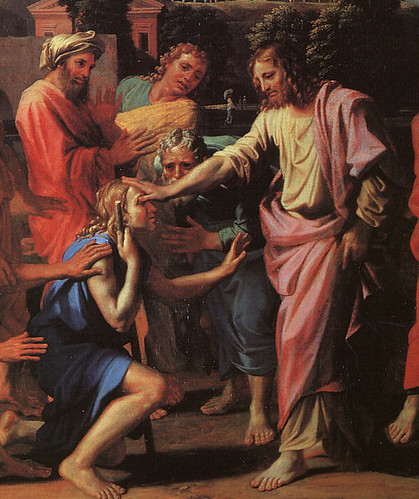 Today we have the 2nd Scrutiny. The Gospel presents us with Christ the Light. Thus, the Scrutiny may be considered an exercise in clarification. How to appreciate the true light and how not to be distracted by lights?
Today we have the 2nd Scrutiny. The Gospel presents us with Christ the Light. Thus, the Scrutiny may be considered an exercise in clarification. How to appreciate the true light and how not to be distracted by lights?In 1992, I visited this hamlet up in the highland interior of Bukidnon—a province in Mindanao, Philippines. The tiny church was an unfinished building and the rectory, the priest’s house, also an uncompleted building. Water was piped from the source just beyond the houses. It was without filtration but was potable. The only electric supply came from a generator used to run the rice mill. Even though the rectory was an unfinished job, the owner of the rice mill saw to it that it was “electrified”. Electricity stopped at about 8 pm. After 8pm, complete darkness except the flickering glow of kerosene lamps. What was arresting was the music wafting through because there was nothing else to do except sing and make music. It is in darkness that one appreciates the light.
When we live in an environment of perpetual light, it becomes harder to appreciate darkness. In pitch darkness one cannot see and so darkness is a symbol of blindness. However, a person in the light may also be blind. Those who can see can also be blind. The First Reading is a good example. Nobody saw anything in the youngest child, David; not even the great prophet Samuel. In the Gospel, everyone who had sight was blind except the blind man. The Gospel illustrates that "sin causes more spiritual blindness" than "physical blindness is the result of sin".
When we choose not to follow God we are in effect declaring that our vision is better than God’s vision. St Paul reminds us that God’s vision is infinitely better than ours. We were once in darkness. Therefore, life’s mistakes are nothing but mistaken attempts to look for enlightenment in the wrong places—ourselves, others, peoples, places. We think that all these can satisfy the heart’s deepest longings. Is that not what St Paul would characterise as the futile works of darkness?
The Gospel is beautiful because it leads us slowly into the light. In so many ways, Christ could have healed the man as simply as: “Say the word, and I shall be healed” reminiscence of the Centurion’s request. He asked Christ to issue the decree of fait accompli. Just by saying so the man could have been healed. But, instead, the Lord’s use of clay brings us back to the Book of Genesis recalling the creation of Man. Christ was not just re-enacting the creation of Man but inviting Man to allow God to re-create him because Christ asked the man to wash himself in the Pool of Siloam. This is how God will re-create us all—through the waters of baptism.
Through baptism, whom do we become but children of God with the stain of sin that blinds us washed away? Baptism allows us to live as children of light.
Exorcism has been hijacked by Hollywood. Sadly so and our idea of exorcism consists of images of turning heads and self-inflicted wounds. Today, exorcism is associated with the occult and expressed through the superlatives—more blood and gore to make it more real. When we believe that exorcism consists of such, we become blind to the reality of what exorcism really is.
For the Second Scrutiny is but a minor exorcism. The Elect are reminded of the reality that Evil is more insidious and subtle. It is real. Thus, in this minor exorcism, the Elect asked to be freed from the grip of evil and darkness so that they can cleave closer to Christ Jesus—to stand bathed in His light.
This light of Christ is so needed by the world. And you begin to appreciate this better if you read further into the story. After his sight had been restored, our blind man still did not know who Jesus was for he had not seen him before. Thus, in answer to the questions "who" and "where", he could only give a “factual” answer that it was Jesus who healed him but as to Jesus’ whereabouts, he could not answer since he did not know how Jesus looked like. And, for witnessing to Jesus whom He has not seen, he was thrown out. Only then did he see Jesus. The subsequent conversation tells us more. Jesus heard that they had driven him away and when He found him He said to him: "Do you believe in the Son of Man"? "Sir, tell me who He is so that I may believe in Him". Jesus said: “You are looking at Him, He is speaking to you”. The blind man with his sight restored said, “Lord, I believe” and worshipped Him. It was a rare occasion where Jesus allowed Himself to be worshipped.
Brothers and sisters, the world needs Jesus Christ and His light. According to St Clement Alexandria “In our sickness we need a Saviour, in our wanderings a guide, in our blindness someone to show us the light, in our thirst the fountain of living water which quenches forever the thirst of those who drink from it. We dead people need life, we sheep need a shepherd, we children need a teacher, the whole world needs Jesus!”
Together with the Elect, we are invited by the Second Scrutiny to “Come into His light”.
